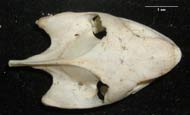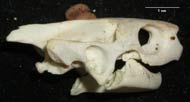Cuora amboinensis, the Malaysian box turtle, is a member of Geoemydidae within Cryptodira. There are six extant species in the genus Cuora, and the three species of Cistoclemmys were formerly considered part of this genus as well (Bonin et al., 2006). The phylogenetic position of Geoemydidae has been debated (e.g., McDowell, 1964; Hirayama, 1984; Gaffney and Meylan, 1988; Spinks et al., 2004), and the clade is currently considered to be the sister-group to Emydidae within Testudinoidea (Joyce, 2007). Geoemydidae originated in the Tertiary, and is therefore a relatively young turtle clade (Ernst and Barbour, 1989; Bonin et al., 2006).
Cuora amboinensis has a small, short skull. There is a plastral hinge between the hyoplastron and hypoplastron that allows the animal to completely close its shell, and the plastron is connected to the carapace by a ligament (Ernst and Barbour, 1989). The carapace is arched, and may reach up to 20cm in length. The digits are partially webbed. Cuora amboinensis ranges in color from dark green to black dorsally and yellow to olive ventrally, with yellow stripes on the side of the head (Ernst and Barbour, 1989; Bonin et al., 2006).
Cuora amboinensis inhabits low-elevation, slow-moving bodies of fresh water, such as ponds, marshes, swamps, and rice paddies throughout Southeast Asia, including Bangladesh, Assam, Myanmar, Thailand, Cambodia, Vietnam, Malaysia, Indonesia, the Philippines, and Japan (Ernst and Barbour, 1989; Bonin et al., 2006). Its diet consists of aquatic vegetation. Females lay three to four clutches of two eggs each per year (Ernst and Barbour, 1989; Bonin et al., 2006). Cuora amboinensis is listed by IUCN as vulnerable, and as endangered in parts of its range.

Literature
Bickham, J.W. and J.L. Carr. 1983. Taxonomy and phylogeny of the higher categories of cryptodiran turtles based on a cladistic analysis of chromosomal data. Copeia 1983:918-932.
Bonin, F., Devaux, B., and A. Dupré. 2006. Turtles of the World. Translated by P.C.H. Pritchard. Johns Hopkins University Press, Baltimore MD.
Ernst, C.H. and R.W. Barbour. 1989. Turtles of the World. Smithsonian Institution Press, Washington DC.
Ferri, V. 2002. Turtles and Tortoises. Firefly Books, Willowdale, ON.
Gaffney, E.S. 1972. An illustrated glossary of turtle skull nomenclature. American Museum Novitates 2486:1-33.
Gaffney, E.S. 1979. Comparative cranial morphology of recent and fossil turtles. Bulletin of the American Museum of Natural History 164:1-376.
Gaffney, E.S. and P.A. Meylan. 1988. A phylogeny of turtles. In: Benton, M.J., editor. The Phylogeny and Classification of the Tetrapods, Volume 1: Amphibians, Reptiles, Birds. Clarendon Press, Oxford, pp. 157-219.
Hirayama, R. 1984. Cladistic analysis of batagurine turtles (Batagurinae: Emydidae: Testudinoidea); a preliminary result. Studia Geologica Salmanticensia Volume Especial 1:141-157.
Honda, M., Yasukawa, Y., Hirayama, R. and H. Ota. 2002. Phylogenetic relationships of the Asian box turtles of the genus Cuora sensu lato (Reptilia : Bataguridae) inferred from mitochondrial DNA sequences. Zoological Science 19:1305-1312.
IUCN 2006. 2006 IUCN Red List of Threatened Species (On-line). Accessed 28 March 2007 at http://www.iucnredlist.org.
Jamniczky, H.A. and A.P. Russell. 2004. A geometric morphometric assessment of the 'batagurine process' of testudinoid turtles. Amphibia-Reptilia 25:369-379.
Joyce, W.G. 2007. A phylogeny of Mesozoic turtles. Bulletin of the Peabody Museum of Natural History 48:3-102.
McDowell, S.B. 1964. Partition of the genus Clemmys and related problems in the taxonomy of aquatic Testudinidae. Proceedings of the Zoological Society of London Series B 143:239-279.
Orenstein, R. 2001. Turtles, Tortoises, and Terrapins: Survivors in Armor. Firefly Books, Buffalo, NY.
Pritchard, P.C.H. 1979. Encyclopedia of Turtles. TFH Publishing, Neptune FL.
Sasaki, T., Yasukawa, Y., Takahashi K., Miura, S., Shedlock, A.M. and N. Okada. 2006. Extensive morphological convergence and rapid radiation in the evolutionary history of the family Geoemydidae (old world pond turtles) revealed by SINE insertion analysis. Systematic Biology 55:912-927.
Shaffer, H.B., Meylan, P., and M.L. McKnight. 1997. Tests of turtle phylogeny: molecular, morphological, and paleontological approaches. Systematic Biology 46:235-268.
Spinks, P.Q., Shaffer, H.B., Iverson, J.B. and W.P. McCord. 2004. Phylogenetic hypotheses for the turtle family Geoemydidae. Molecular Phylogenetics and Evolution 32:164-182.
Links
Cuora amboinensis page on Animal Diversity Web
Cuora amboinensis page on Ecology Asia











